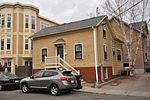WJIB (740 AM) is a radio station based in Cambridge, Massachusetts and serving the Boston DMA. The playlist draws from 5,400 records, concentrating on adult standards from the 1930s through the 1960s, and softer pop music from the 1950s and 1960s. It is owned by Bob Bittner Broadcasting, along with sister station WJTO in Bath, Maine. WJIB runs no commercial advertisements (instead relying on listener donations, in the same vein as a non-commercial station), and broadcast in AM stereo until the summer of 2012. On August 4, 2017, the station began simulcasting on an FM translator at 101.3 MHz, W267CE.
WJIB is an indirect successor to a previous Boston FM station at 96.9 MHz with the same call sign (now WBQT, owned by Beasley Broadcast Group) which in turn descended from WXHR, one of the first FM stations in the Boston area. Coincidentally, what is now WJIB was once owned by Harvey Radio Laboratories, the same company that owned WXHR/WJIB-FM. The AM station was first known as WTAO, then WXHR, and later as WCAS. In 1967, a year after they were sold to a joint venture of Kaiser Broadcasting and the Boston Globe, WXHR became WCAS while WXHR-FM changed to WJIB, featured the beautiful music format, and became well known for a nautical-themed station identification featuring a buoy bell and a seagull (now used in modified form by WOCN-FM on Cape Cod). WJIB-FM became WCDJ, a smooth jazz station, in 1990, and the call sign WJIB lapsed.
After Kaiser/Globe took over, the AM side at first broadcast a format with music and local news of interest to listeners in Cambridge and nearby communities, but was not very successful. By 1969, WCAS had flipped to Oldies. This was followed in 1972 by a soft rock format that, by 1973, had evolved into a folk/rock format which, while not enormously successful, gained a devoted following in the Boston area. In 1974 and then again in 1975, WCAS was almost sold to religious broadcasters, but both times, citizens groups intervened and thwarted the sales. The format continued even after Kaiser finally sold the station, in 1976, but ended with a sale of the station in 1981 after the then-owners, Dan Murphy and Mel Stone, were forced to file bankruptcy for WCAS. The rest of the 1980s would see a revolving door of owners, call letters, and formats. In the summer of 1991, Bob Bittner purchased the station, then known as WLVG ("We love God") and programming a Black Gospel format. Bittner changed the format to "Earth Radio" (a blend of contemporary music with environmentally-aware public service spots) under the call letters WWEA.
The WJIB call letters were applied for by Bittner in 1992 and were granted to him by the Federal Communications Commission (FCC) for the 740 station in Cambridge. Once having gained the WJIB call letters, Bittner switched the station to beautiful music on August 4, 1992, expanding it slightly as the station gained success, and then gradually morphed it into an adult standards station with a slight remainder of beautiful music in the mix, totally programmed by Bittner (WJTO is an almost exact copy music-wise). The station's studio still occupies a section of the original building owned by Harvey Radio Labs, the original proprietors of WXHR and WTAO.
Originally a daytime-only station, WJIB gained nighttime power in the early 1990s with an output of five watts. Despite this meager power, WJIB's nighttime signal can be heard inside of Massachusetts Route 128; just outside the 128 belt, listeners usually get Toronto's CFZM at night, with a format similar to that of WJIB.
During the spring and summer of 2006, a small construction developer circulated a petition in the local Fresh Pond, Cambridge neighborhood to gauge community support or opposition for tearing down the Concord Avenue buildings that originally housed WTAO and currently house WJIB. The firm proposed the removal of the buildings owned by Cambridge Self Storage, a rental storage company, and their replacement with 220+ 3-4 story condominiums and townhouses. The proposal ran into considerable community opposition, citing traffic congestion on Concord Avenue and surrounding roads.








